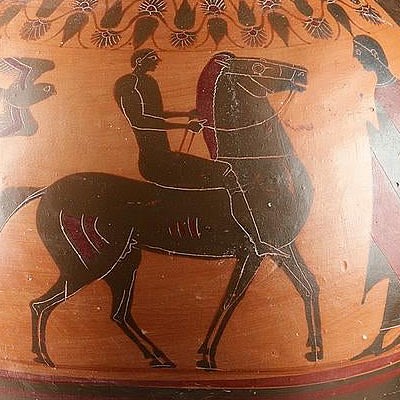Rare Canaanite Terracotta Chariot with Rider
Lot 86d
About Seller
Artemis Gallery
686 S Taylor Ave, Ste 106
Louisville, CO 80027
United States
Selling antiquities, ancient and ethnographic art online since 1993, Artemis Gallery specializes in Classical Antiquities (Egyptian, Greek, Roman, Near Eastern), Asian, Pre-Columbian, African / Tribal / Oceanographic art. Our extensive inventory includes pottery, stone, metal, wood, glass and textil...Read more
Categories
Estimate:
$2,500 - $3,500
Absentee vs Live bid
Two ways to bid:
- Leave a max absentee bid and the platform will bid on your behalf up to your maximum bid during the live auction.
- Bid live during the auction and your bids will be submitted real-time to the auctioneer.
Bid Increments
| Price | Bid Increment |
|---|---|
| $0 | $25 |
| $300 | $50 |
| $1,000 | $100 |
| $2,000 | $250 |
| $5,000 | $500 |
| $10,000 | $1,000 |
| $20,000 | $2,500 |
| $50,000 | $5,000 |
| $100,000 | $10,000 |
| $200,000 | $20,000 |
About Auction
By Artemis Gallery
Jun 4, 2020
Set Reminder
2020-06-04 10:00:00
2020-06-04 10:00:00
America/New_York
Bidsquare
Bidsquare : Exceptional Antiquities, Asian, Ethnographic
https://www.bidsquare.com/auctions/artemis-gallery/exceptional-antiquities-asian-ethnographic-5185
An important one-day auction featuring museum-worthy examples of Egyptian, Greek, Roman, Etruscan, Near Eastern, Far East / Asian, Pre-Columbian, African / Tribal, Oceanic, Native American, Spanish Colonial, Russian, Fossils, Ancient Jewelry, Fine Art, so much more! Artemis Gallery info@artemisgallery.com
An important one-day auction featuring museum-worthy examples of Egyptian, Greek, Roman, Etruscan, Near Eastern, Far East / Asian, Pre-Columbian, African / Tribal, Oceanic, Native American, Spanish Colonial, Russian, Fossils, Ancient Jewelry, Fine Art, so much more! Artemis Gallery info@artemisgallery.com
- Lot Description
Ancient Near East, Levant, Canaanite or Syro-Hittite, ca. 1500 BCE. A hand-built charioteer riding his two-wheeled chariot drawn by a pair of horses or other quadrupeds. The rider stands upon the two-wheeled platform vehicle and grasps the rail. To the Canaanites and the Syro-Hittites, the defense of cities was of the utmost importance. Initially hand to hand combat with spears and/or axes was the modus operandi. However, the introduction of the horse-drawn chariot changed tactics on the field of battle enabling riding warriors to shoot arrows against the enemy formations while whirring about. Size: 4.7" L x 8.9" W x 5.8" H (11.9 cm x 22.6 cm x 14.7 cm)
This piece is part of a longstanding tradition in the ancient Near East of pottery figures depicting both religious themes and themes of everyday life. A worshipper would have given this chariot as a ritual offering and it may have held gifts or food placed inside of it. The chariot was not only a practical form of transportation but it also symbolized the war-like nature of the gods - frequently seen in carved reliefs running over the bodies of enemies.
Provenance: private New York, New York, USA collection; ex prominent DK collection, New York, New York, USA, acquired in 2000s
All items legal to buy/sell under U.S. Statute covering cultural patrimony Code 2600, CHAPTER 14, and are guaranteed to be as described or your money back.
A Certificate of Authenticity will accompany all winning bids.
We ship worldwide and handle all shipping in-house for your convenience.
#155721Wheels have been reattached with materials that complement the ancient chariot. The figure has been expertly repaired where the figure's arms meet the chariot and at the center of the front of the chariot.Condition
- Shipping Info
-
All shipping is handled in-house for your convenience. Your invoice from Artemis Gallery will include shipping calculation instructions. If in doubt, please inquire BEFORE bidding for estimated shipping costs for individual items.
-
- Buyer's Premium



 EUR
EUR CAD
CAD AUD
AUD GBP
GBP MXN
MXN HKD
HKD CNY
CNY MYR
MYR SEK
SEK SGD
SGD CHF
CHF THB
THB















